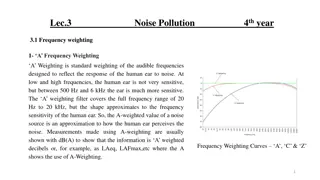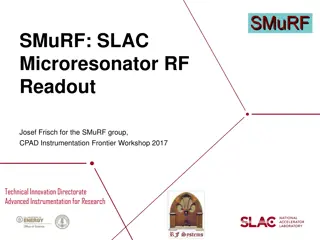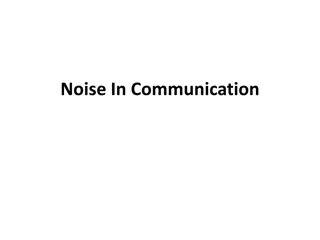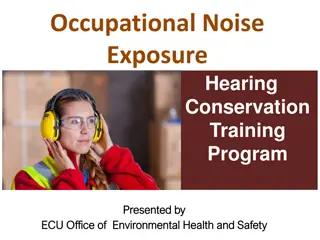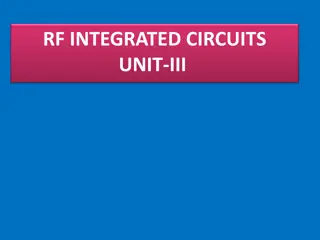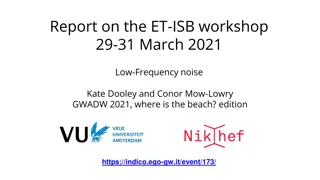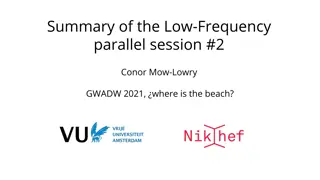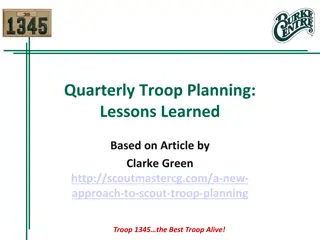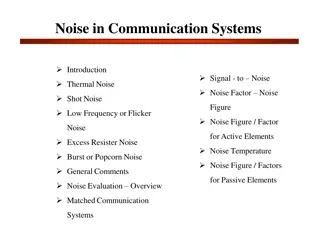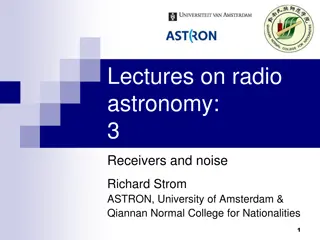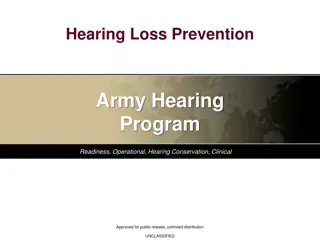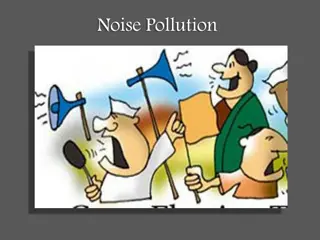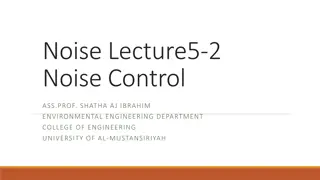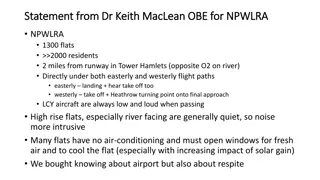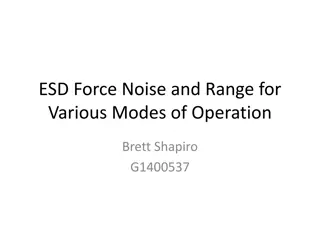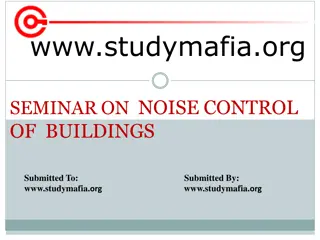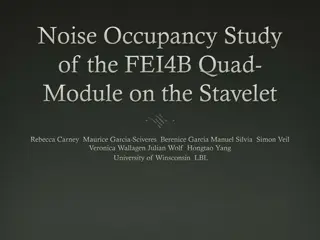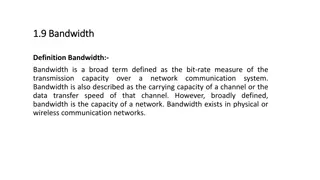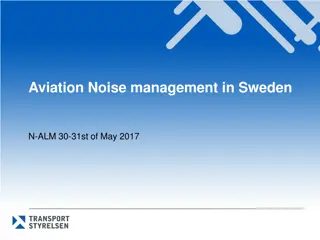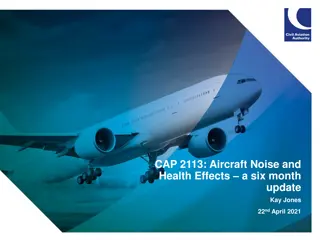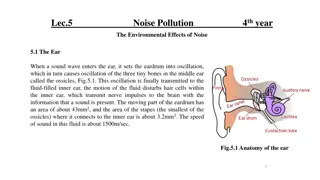
Understanding FAA Noise Research and Policy Updates
Explore the Federal Aviation Administration's research roadmap and updates on reducing aircraft noise around U.S. airports, including goals, drivers of research, annoyance evaluation, health outcomes, and sleep studies. Learn about efforts to protect public health and welfare from aviation noise impacts and how policies are being re-evaluated for the future.
Download Presentation

Please find below an Image/Link to download the presentation.
The content on the website is provided AS IS for your information and personal use only. It may not be sold, licensed, or shared on other websites without obtaining consent from the author. If you encounter any issues during the download, it is possible that the publisher has removed the file from their server.
You are allowed to download the files provided on this website for personal or commercial use, subject to the condition that they are used lawfully. All files are the property of their respective owners.
The content on the website is provided AS IS for your information and personal use only. It may not be sold, licensed, or shared on other websites without obtaining consent from the author.
E N D
Presentation Transcript
Noise Research Roadmap and Update Federal Aviation Administration Presented to: REDAC E&E Subcommittee By: Rebecca Cointin, Manager, AEE-100 August 6, 2015 Date:
Noise Goal Reduce the number of people exposed to significant noise around U.S. airports in absolute terms, notwithstanding aviation growth, and provide additional measures to protect public health and welfare and our national resources. Specifically, by 2018, have the U.S. population exposed to significant aircraft noise around airports have been reduced to less than 300,000 persons Research is examining the appropriateness of the level of significance, potential for other metrics and evaluating the long-term goal Federal Aviation Administration 2
Drivers of Research Observation: Even though the number of people in the U.S. exposed to significant aircraft noise since 1975 has dropped by 95 percent, complaints, opposition and challenges continue to be an issue Needs: Gather data to determine if there has been a significant change in the public perception of noise Gather supplemental data to develop strong scientific support for any policy decisions regarding aviation noise Federal Aviation Administration 3
Federal Aviation Administration 4
ANNOYANCE Re-Evaluate Threshold Research: 2014 end of 2016 Evaluation of Policy (2017) Coordination CBA Public Process (2018 2019) FR Notice of Policy Rulemaking for Regulations to be updated Re-Evaluate Metric Effort: 2017 2019 Use Survey data Consider other impacts in Research Roadmap Re-Evaluate Policy Effort: 2020 2025 Metric and Threshold Draft Deliberative. Not for Release. Subject to Change.
HEALTH Outcome: Quantified risk of cardiovascular disease COE WHI Study (2014 2016) Significant signal? Do results vary with DNL level? Are other metrics needed? Next Step (2016 2018) Ideally 1 2 more cohorts with consistent results to establish scientific basis Tools linkage: Ensure AEDT/APMT-Impact can compute what is needed Translate costs to APMT-Impacts Draft Deliberative. Not for Release. Subject to Change.
SLEEP FY 14 15 effort (funded) Small field study (testing method) FY15 effort (funded) Analyze small field study results FY 15 16 effort (funded) Another small field Cheaper equipment/less invasive Prepare for large scale field study FY 17 18 effort (funding TBD) Examine dose response (awakening vs noise metric) Analyze data from study Create additional method as needed Establish scientific basis Incorporate into AEDT and APMT-Impacts Draft Deliberative. Not for Release. Subject to Change.
CHILDRENS LEARNING ACRP 02-47 (2014 2016) Case Studies Goal: in-depth reaction; inside/outside measurement and correlated reaction Link between aircraft noise and learning (from previous ACRP) Statistical significance exists Insulation does matter Criteria to mitigate Plan to look at reaction at a few more school districts (i.e. expand ACRP) Need to determine where: types of districts, willingness to participate, and NLR Establish scientific basis (2018 2019) Open Questions: Do we examine link to home life? Link to sleep?
Project Status Updates Federal Aviation Administration 9
FY15 Noise Projects AEE Funded Noise Impact Health Research Noise emission and propagation modeling Civil, supersonic over flight, sonic boom (noise) standards development Noise Outreach Sleep Disturbance Support ASA Workgroup on dose-response for National Parks Ray Tracing Development for Modeling Launch Noise and Sonic Boom Research Aircraft Certification (CAEP support, validation tool development, validation) Rotorcraft Noise Abatement Procedure Development Examine airline flight data to improve flight performance modeling PBN Research Helicopter Noise Annoyance ARP Funded National Survey Federal Aviation Administration 10
National Survey Objective Conduct a new nation-wide survey to update the scientific evidence of the relationship between aircraft noise exposure and its effects on communities around airports Status Contract for the last two phases of work has been awarded Surveys will begin this summer Federal Aviation Administration 11
Performance Based Navigation Research Examining the effects of PBN procedures which may focus of noise on populations Research on Metrics just kicked off Compute multiple metrics to determine the best metrics that correlate the effects of PBN procedures with public perception Goal: Identify potential supplemental metrics for PBN analysis Project team includes members of AJV-114 (part of ATO) Federal Aviation Administration 12
Impacts Research Health Working with the Women s Health Initiative Database Noise data for certain individuals around airports in the database from 2000 2014 will be provided to the team Analysis of potential health impacts will begin once noise data is provided to the team Sleep Finishing pilot study around single US airport Beginning to explore another pilot study with a methodology aimed to be less invasive (mailing of equipment and self-administered) Federal Aviation Administration 13
Helicopter Projects Rotorcraft Noise Abatement Procedure Development Successful integration of noise prediction code, rotor loads and wake prediction model, and flight control model System validated using Bell 430 flight test data - good agreement Predictions have been made for various flight conditions: altitudes, airspeeds, and climb/descent slopes Helicopter Noise Annoyance Test plan was developed to conduct a helicopter noise annoyance survey in the LA basis, which included development of a Smart Phone App to log complaints and selection of volunteers for the test Testing occurred with five volunteers for ten days with monitoring Goals: Test whether these subject reactions and noise levels can be accurately collected and combined into a useful database. Use the database to test whether some noise measures other than the ones now commonly used to assess fixed wing noise annoyance should be considered for predicting helicopter. Federal Aviation Administration 14
Noise Complaint Initiative Representatives from across the lines of business and staff offices Two Goals: Identify a consistent agency-wide process for addressing noise complaints Identify actions the FAA might take to better address the underlying issues raised by the complaints, including increased community engagement and further minimizing noise impacts where possible Team recommendations are being finalized and will be presented to FAA executives in the Fall Federal Aviation Administration 15
Supersonics International Work Identifying potential noise certification measurement points Identifying potential noise certification metrics Boom Metrics Variability Study Explore the sensitivities of turbulence on sonic boom metrics using available measured data Impulsive-Response Database Review Review of existing impulsive noise databases were compared for similarities of human response and studied to ranks drivers Strongest Drivers: interference, startle, loudness, vibration, and rattle Federal Aviation Administration 16
Propagation Ray Tracing Development for Modeling Continue to implement ray modeling into future AEDT, current focus on predicting SEL (flight event) Worked out detailed steps (de-propagation to source and re- propagation to receiver), and started preliminary coding Next Steps are layered atmosphere modeling, model verification and validation, and runtime optimization Noise emission and propagation modeling Continue to develop prediction capability (i.e. Fast Field Program/ray) and investigate effects of source motion and atmospheric data Able to predict realistic overflight scenarios with effects (and interaction) of source motion, upper air atmospheric absorption etc Next Steps is to access field measurement data for models validation, effective handling of meteorological data Federal Aviation Administration 17

